The Prediction of Pervious Concrete Compressive Strength Based on a Convolutional Neural Network
Abstract
1. Introduction
2. Data Source and Model Testing
2.1. Data Source
2.2. Model Information
2.2.1. Background
2.2.2. CNN Structure
2.3. Model Training and Testing
3. Results and Discussion
3.1. CNN Model Predictive Performance
3.2. Improvements in CNN Model Training
3.2.1. Enhancements for Improved Robustness of the Model
3.2.2. Method for Enhancing Model Robustness
- (1)
- Experimental Materials
- (2)
- Experimental Procedure
3.2.3. Predictive Performance after Model Training Enhancement
3.3. Comparative Analysis between CNN and Other Prediction Methods
4. Conclusions
- (I)
- The proposed CNN model showcased remarkable accuracy. Through multiple experiments, the CNN model achieved an R2 of 0.938 and a MAPE of 9.13% on the test set, indicating acceptable prediction errors and robust model stability. This underscores the CNN model’s capability to precisely predict the 28-day compressive strength of pervious concrete, making it adaptable to diverse material compositions.
- (II)
- The predictive model presented in this paper demonstrates enhanced stability and outperforms traditional methods. In comparison to the BP neural network trained and tested on the same dataset, the CNN model exhibits considerably lower prediction error metrics (RMSE, MAE, and MAPE) and notably higher R2, signifying superior predictive performance and stability compared to traditional approaches.
- (III)
- This study supplemented the model training with experimental data encompassing the compressive strength range of 10–20 MPa for pervious concrete, ensuring coverage of the common compressive strength spectrum of pervious concrete. The test set results indicate that the model data augmented with experimental data performs well in predicting data obtained from different literature sources as well as data acquired through experiments.
Author Contributions
Funding
Data Availability Statement
Conflicts of Interest
References
- Seeni, B.S.; Madasamy, M. Factors influencing performance of pervious concrete. Gradevinar 2021, 73, 1017–1030. [Google Scholar]
- AlShareedah, O.; Nassiri, S. Pervious concrete mixture optimization, physical, and mechanical properties and pavement design: A review. J. Clean. Prod. 2021, 288, 125095. [Google Scholar] [CrossRef]
- Zeng, Q.; Jike, N.; Xu, C.J.; Yang, R.J.; Peng, Y.; Wang, J.Y.; Gong, F.Y.; Zhang, M.Z.; Zhao, Y.X. Total recycling of low-quality urban-fringe construction and demolition waste towards the development of sustainable cement-free pervious concrete: The proof of concept. J. Clean. Prod. 2022, 352, 131464. [Google Scholar] [CrossRef]
- Wang, H.; Chen, X. Life-cycle assessment and multi-criteria performance evaluation of pervious concrete pavement with fly ash. Resour. Conserv. Recycl. 2022, 177, 105969. [Google Scholar]
- Kim, T.; Jang, H.; Kim, C.S.; Kim, J.; Rafieizonooz, M.; Khankhaje, E. Properties of pervious concrete incorporating fly ash as partial replacement of cement: A review. Dev. Built Environ. 2023, 14, 100130. [Google Scholar]
- Kapoor, K.; Singh, S.P.; Nazeer, M. Strength, durability and microstructural investigations on pervious concrete made with fly ash and silica fume as supplementary cementitious materials. J. Build. Eng. 2023, 69, 106275. [Google Scholar]
- Tang, B.; Sun, X.; He, X.; Yuan, L.; Fan, M. Experimental study on the water purification performance of carbonated recycled aggregate pervious concrete. Constr. Build. Mater. 2023, 406, 133392. [Google Scholar]
- Sheng, J.; Li, W.; Yu, M.; Zheng, X.; Wang, F.; Li, Y. Effect of a novel spherical tailings aggregate on the macro- and mesoscopic properties of pervious concrete. Cem. Concr. Compos. 2023, 144, 105311. [Google Scholar]
- Fan, M.; Yang, Z.; Sun, Y.; Yuan, L.; Tang, B. A comparison study of aggregate carbonation and concrete carbonation for the enhancement of recycled aggregate pervious concrete. Constr. Build. Mater. 2023, 371, 130797. [Google Scholar]
- Qin, Y.; Pang, X.; Tan, K.; Bao, T. Evaluation of pervious concrete performance with pulverized biochar as cement replacement. Cem. Concr. Compos. 2021, 119, 104022. [Google Scholar] [CrossRef]
- Fei, M.; Luo, C.; Zheng, X.; Fu, T.; Ling, K.; Chen, H.; Liu, W.; Qiu, R. High-performance pervious concrete using cost-effective modified vinyl ester as binder. Constr. Build. Mater. 2024, 414, 134908. [Google Scholar] [CrossRef]
- Singh, A.; Charak, A.; Biligiri, K.P.; Pandurangan, V. Glass and carbon fiber reinforced polymer composite wastes in pervious concrete: Material characterization and lifecycle assessment. Resour. Conserv. Recycl. 2022, 182, 106304. [Google Scholar] [CrossRef]
- Hari, R.; Mini, K.M. Mechanical and durability properties of basalt-steel wool hybrid fibre reinforced pervious concrete—A Box Behnken approach. J. Build. Eng. 2023, 70, 106307. [Google Scholar] [CrossRef]
- Ozel, B.F.; Sakallı, Ş.; Şahin, Y. The effects of aggregate and fiber characteristics on the properties of pervious concrete. Constr. Build. Mater. 2022, 356, 129294. [Google Scholar] [CrossRef]
- Chen, X.; Yang, Y.; Zhang, H.; Du, X.; Chen, L.; Zhao, Q.; Li, B. Brick-concrete recycled aggregate/powder synergistic preparation of pervious concrete. Constr. Build. Mater. 2023, 407, 133517. [Google Scholar] [CrossRef]
- Supit, S.; Priyono, W.M. Utilization of recycled PET plastic waste as replacement of coarse aggregate in pervious concrete. Mater. Today Proc. 2022, 66, 2990–2995. [Google Scholar] [CrossRef]
- Song, H.; Yao, J.; Xiang, J. The role of aggregate and cement paste in the deterioration of the transitional interface zone of pervious concrete during freeze-thaw cycles. Case Stud. Constr. Mater. 2022, 16, e01086. [Google Scholar] [CrossRef]
- Arun, A.; Chekravarty, D. Strength improvement techniques on pervious concrete. Mater. Today Proc. 2022, 52, 1979–1985. [Google Scholar] [CrossRef]
- Cai, J.; Chen, J.G.; Shi, J.; Tian, Q.; Xu, G.; Du, Y. A novel approach to evaluate the clogging resistance of pervious concrete. Case Stud. Constr. Mater. 2022, 16, e00864. [Google Scholar] [CrossRef]
- Brasileiro, K.P.T.V.; de Oliveira Nahime, B.; Lima, E.C.; Alves, M.M.; Ferreira, W.P.; dos Santos, I.S.; Bezerra Filho, C.P.; dos Reis, I.C. Influence of recycled aggregates and silica fume on the performance of pervious concrete. J. Build. Eng. 2024, 82, 108347. [Google Scholar] [CrossRef]
- Zheng, X.; Pan, J.; Easa, S.; Fu, T.; Liu, H.; Liu, W.; Qiu, R. Utilization of copper slag waste in alkali-activated metakaolin pervious concrete. J. Build. Eng. 2023, 76, 107246. [Google Scholar] [CrossRef]
- Adresi, M.; Yamani, A.; Tabarestani, M.K.; Rooholamini, H. A comprehensive review on pervious concrete. Constr. Build. Mater. 2023, 407, 133308. [Google Scholar] [CrossRef]
- Zhu, Y.; Fu, H.; Wang, P.; Xu, P.; Ling, Z.; Wei, D. Pore structure characteristics, mechanical properties, and freeze–thaw resistance of vegetation-pervious concrete with unsintered sludge pellets. Constr. Build. Mater. 2023, 382, 131342. [Google Scholar] [CrossRef]
- He, S.-S.; Jiao, C.J.; Li, S. Investigation of mechanical strength and permeability characteristics of pervious concrete mixed with coral aggregate and seawater. Constr. Build. Mater. 2023, 363, 129508. [Google Scholar] [CrossRef]
- Chockalingam, T.; Vijayaprabha, C.; Raj, J.L. Experimental study on size of aggregates, size and shape of specimens on strength characteristics of pervious concrete. Constr. Build. Mater. 2023, 385, 131320. [Google Scholar] [CrossRef]
- El-Hassan, H.; Kianmehr, P.; Tavakoli, D.; El-Mir, A.; Dehkordi, R.S. Synergic effect of recycled aggregates, waste glass, and slag on the properties of pervious concrete. Dev. Built Environ. 2023, 15, 100189. [Google Scholar] [CrossRef]
- Sathiparan, N.; Jeyananthan, P.; Subramaniam, D.N. Surface response regression and machine learning techniques to predict the characteristics of pervious concrete using non-destructive measurement: Ultrasonic pulse velocity and electrical resistivity. Measurement 2024, 225, 114006. [Google Scholar] [CrossRef]
- Berloco, F.; Bevilacqua, V.; Colucci, S. Distributed analytics for big data: A survey. Neurocomputing 2024, 574, 127258. [Google Scholar] [CrossRef]
- Selmy, H.A.; Mohamed, H.K.; Medhat, W. Big data analytics deep learning techniques and applications: A survey. Inf. Syst. 2024, 120, 102318. [Google Scholar] [CrossRef]
- Khan, A.Q.; Awan, H.A.; Rasul, M.; Siddiqi, Z.A.; Pimanmas, A. Optimized artificial neural network model for accurate prediction of compressive strength of normal and high strength concrete. Clean. Mater. 2023, 10, 100211. [Google Scholar] [CrossRef]
- de-Prado-Gil, J.; Martínez-García, R.; Jagadesh, P.; Juan-Valdés, A.; Gónzalez-Alonso, M.I.; Palencia, C. To determine the compressive strength of self-compacting recycled aggregate concrete using artificial neural network (ANN). Ain Shams Eng. J. 2023, 15, 102548. [Google Scholar] [CrossRef]
- Bingöl, A.F.; Tortum, A.; Gül, R. Neural networks analysis of compressive strength of lightweight concrete after high temperatures. Mater. Des. 2013, 52, 258–264. [Google Scholar] [CrossRef]
- Sui, C.; Qiao, D.; Wu, Y.; Zhu, H.; Lan, H.; Yang, W.; Guo, Q. Study of the Effect of Retarder and Expander on the Strength and Cracking Performance of Rubber Concrete Based on Back Propagation Neural Network. Materials 2023, 16, 6976. [Google Scholar] [CrossRef] [PubMed]
- Wang, K.W.; Ren, J.; Yan, J.; Wu, X.; Dang, F. Research on a concrete compressive strength prediction method based on the random forest and LCSSA-improved BP neural network. J. Build. Eng. 2023, 76, 107150. [Google Scholar] [CrossRef]
- Li, T.; Xiao, J.; Singh, A. Strength index analysis of concrete with large size recycled aggregate based on back propagation neural network. Adv. Struct. Eng. 2022, 25, 133–145. [Google Scholar] [CrossRef]
- Wang, H.; Zhao, K.; Zhang, Y.; Zhang, X. Prediction of Compressive Strength of Concrete Using the Spearman and PCA-Based BP Neural Network. Wirel. Commun. Mob. Comput. 2022, 2022, 1–10. [Google Scholar] [CrossRef]
- AL-Bukhaiti, K.; Liu, Y.; Zhao, S.; Abas, H. An Application of BP Neural Network to the Prediction of Compressive Strength in Circular Concrete Columns Confined with CFRP. Ksce J. Civ. Eng. 2023, 27, 3006–3018. [Google Scholar] [CrossRef]
- Park, J.-R.; Lee, H.-J.; Yang, K.-H.; Kook, J.-K.; Kim, S. Study on Influence of Range of Data in Concrete Compressive Strength with Respect to the Accuracy of Machine Learning with Linear Regression. Appl. Sci. 2021, 11, 3866. [Google Scholar] [CrossRef]
- Chi, L.; Wang, M.; Liu, K.; Lu, S.; Kan, L.; Xia, X.; Huang, C. Machine learning prediction of compressive strength of concrete with resistivity modification. Mater. Today Commun. 2023, 36, 106470. [Google Scholar] [CrossRef]
- Huang, J.; Sabri, M.M.S.; Ulrikh, D.V.; Ahmad, M.; Alsaffar, K.A.M. Predicting the Compressive Strength of the Cement-Fly Ash–Slag Ternary Concrete Using the Firefly Algorithm (FA) and Random Forest (RF) Hybrid Machine-Learning Method. Materials 2022, 15, 4193. [Google Scholar] [CrossRef]
- Cui, X.; Wang, Q.; Zhang, R.; Dai, J.; Li, S. Machine learning prediction of concrete compressive strength with data enhancement. J. Intell. Fuzzy Syst. 2021, 41, 7219–7228. [Google Scholar] [CrossRef]
- Shi, M.; Shen, W. Automatic Modeling for Concrete Compressive Strength Prediction Using Auto-Sklearn. Buildings 2022, 12, 1406. [Google Scholar] [CrossRef]
- Kumar, M.; Singh, S.; Kim, S.; Anand, A.; Pandey, S.; Hasnain, S.M.; Ragab, A.E.; Deifalla, A.F. A hybrid model based on convolution neural network and long short-term memory for qualitative assessment of pervious and porous concrete. Case Stud. Constr. Mater. 2023, 19, e02254. [Google Scholar]
- Khademi, P.; Toufigh, V. HPASC—OPCC bi-surface shear strength prediction model using deep learning. Road Mater. Pavement Des. 2023, 24, 1765–1792. [Google Scholar] [CrossRef]
- Huang, W.; Quan, W.; Ge, P. Orthogonal tests investigation into hybrid fiber-reinforce recycled aggregate concrete and convolutional neural network prediction. J. Asian Archit. Build. Eng. 2022, 21, 986–1001. [Google Scholar] [CrossRef]
- Ranjbar, I.; Toufigh, V.; Boroushaki, M. A combination of deep learning and genetic algorithm for predicting the compressive strength of high-performance concrete. Struct. Concr. 2022, 23, 2405–2418. [Google Scholar] [CrossRef]
- Zeng, Z.; Zhu, Z.; Yao, W.; Wang, Z.; Wang, C.; Wei, Y.; Wei, Z.; Guan, X. Accurate prediction of concrete compressive strength based on explainable features using deep learning. Constr. Build. Mater. 2022, 329, 127082. [Google Scholar] [CrossRef]
- Singh, S.B.; Murugan, M.; Chellapandian, M.; Dixit, S.; Bansal, S.; Reddy, K.S.K.; Gupta, M.; Vafaeva, K.M. Effect of fly ash addition on the mechanical properties of pervious concrete. Mater. Today Proc. 2023. [Google Scholar] [CrossRef]
- Seeni, B.S.; Madasamy, M.; Chellapandian, M.; Arunachelam, N. Effect of silica fume on the physical, hydrological and mechanical properties of pervious concrete. Mater. Today Proc. 2023. [Google Scholar] [CrossRef]
- Sun, Y.; Gao, P.; Geng, F.; Li, H.; Zhang, L.; Liu, H. Thermal conductivity and mechanical properties of porous concrete materials. Mater. Lett. 2017, 209, 349–352. [Google Scholar] [CrossRef]
- Agar-Ozbek, A.S.; Weerheijm, J.; Schlangen, E.; Van Breugel, K. Investigating porous concrete with improved strength: Testing at different scales. Constr. Build. Mater. 2013, 41, 480–490. [Google Scholar] [CrossRef]
- Chen, Y.; Wang, K.; Wang, X.; Zhou, W. Strength, fracture and fatigue of pervious concrete. Constr. Build. Mater. 2013, 42, 97–104. [Google Scholar] [CrossRef]
- Rezania, M.; Panahandeh, M.; Razavi, N.; Berto, F. Experimental study of the simultaneous effect of nano-silica and nano-carbon black on permeability and mechanical properties of the concrete. Theor. Appl. Fract. Mech. 2019, 104, 102391. [Google Scholar] [CrossRef]
- Deng, F.; He, Y.; Zhou, S.; Yu, Y.; Cheng, H.; Wu, X. Compressive strength prediction of recycled concrete based on deep learning. Constr. Build. Mater. 2018, 175, 562–569. [Google Scholar] [CrossRef]
- JGJ 63-2006; Ministry of Housing and Urban-Rural Construction of the People’s Republic of China. Standard of Water for Concrete. China Building Industry Press: Beijing, China, 2006. (In Chinese)
- GB/T 50081-2019; Ministry of Housing and Urban-Rural Construction of the People’s Republic of China. Standard for Test Method of Mechanical Properties on Ordinary Concrete. China Building Industry Press: Beijing, China, 2002. (In Chinese)
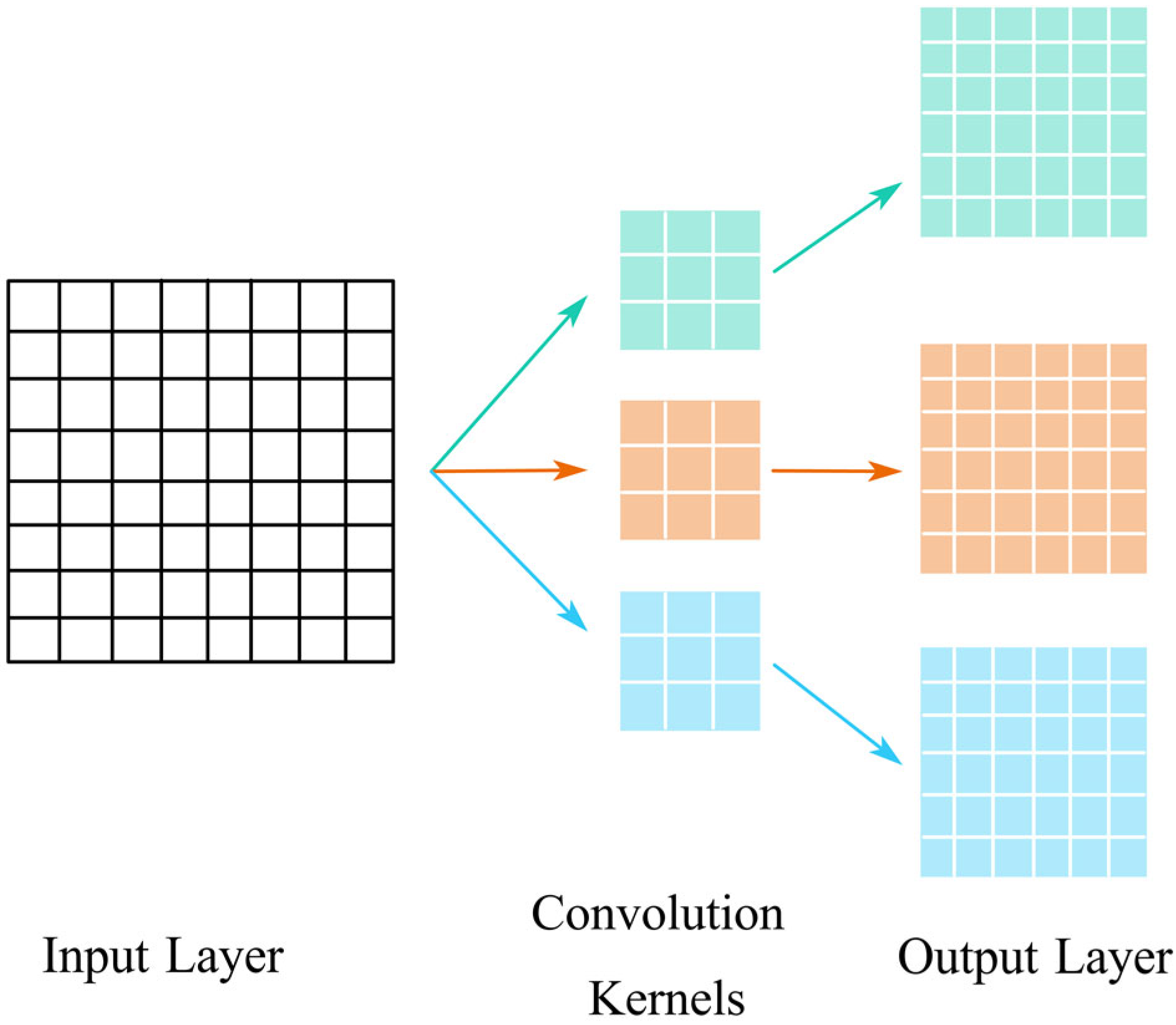
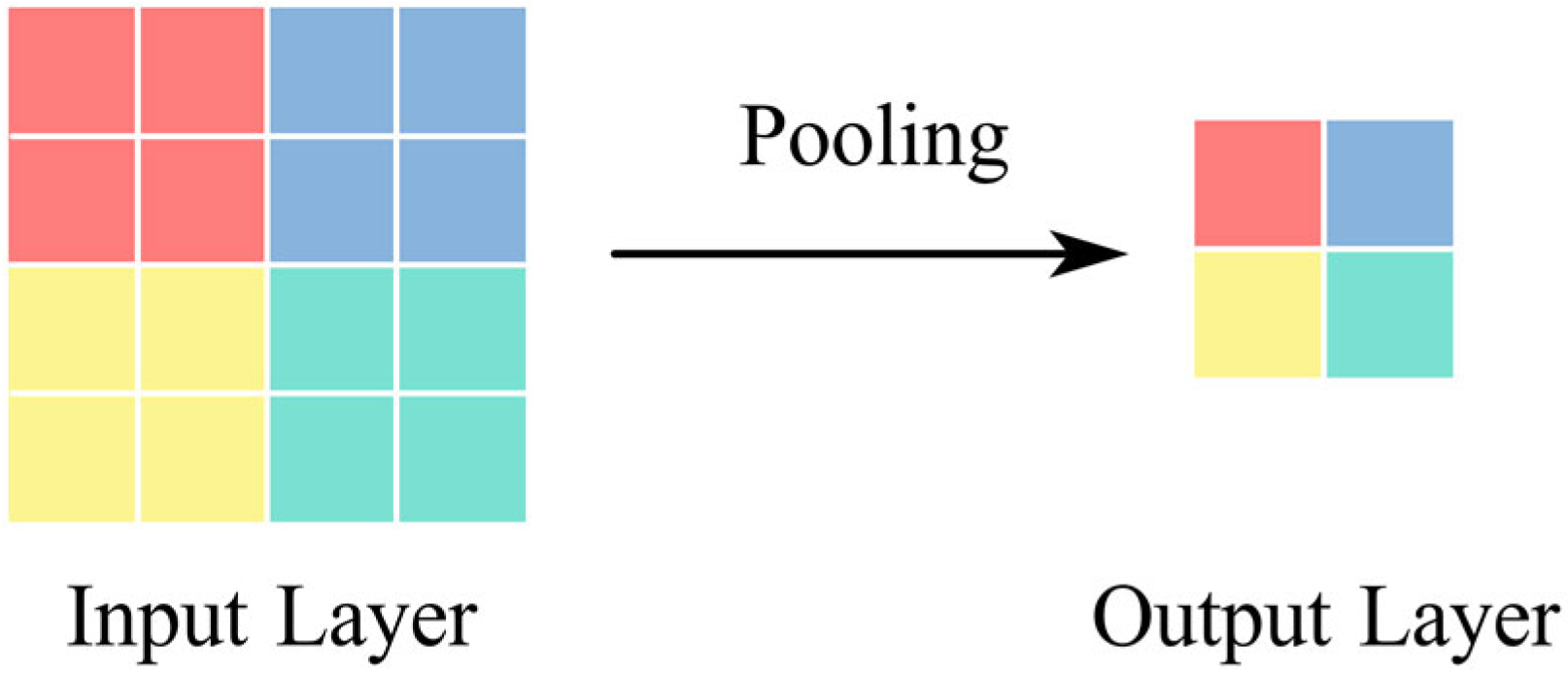
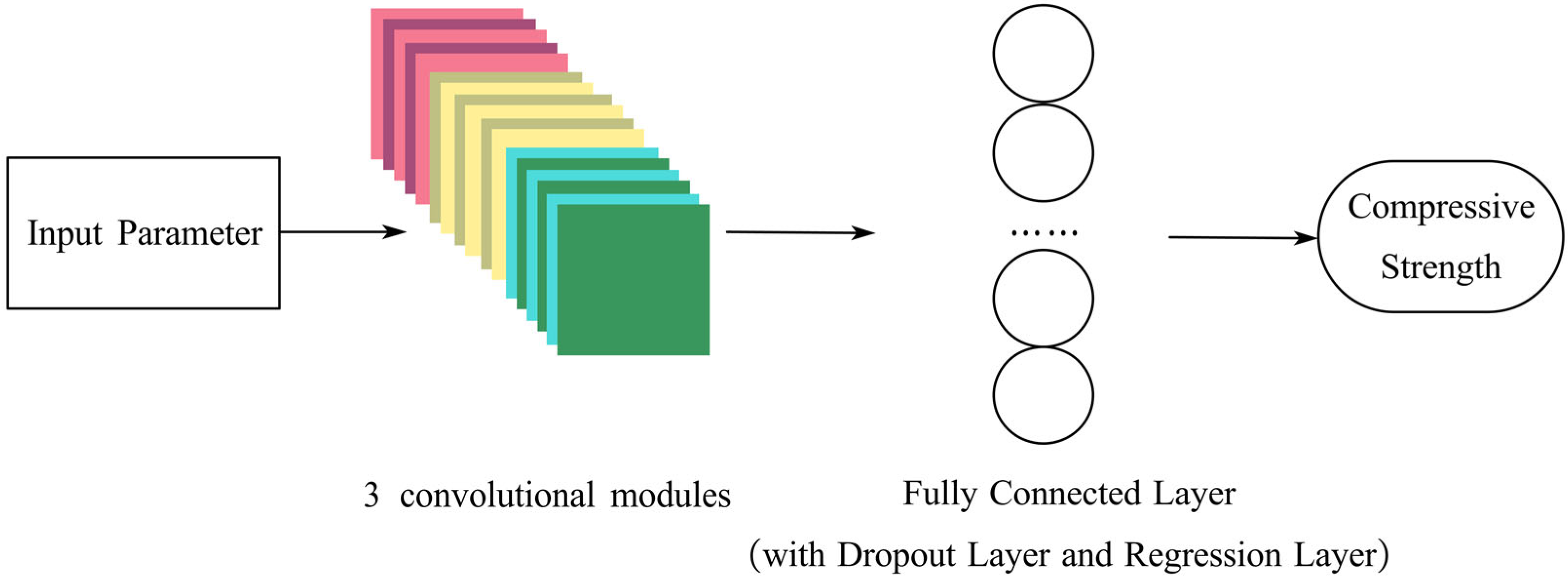
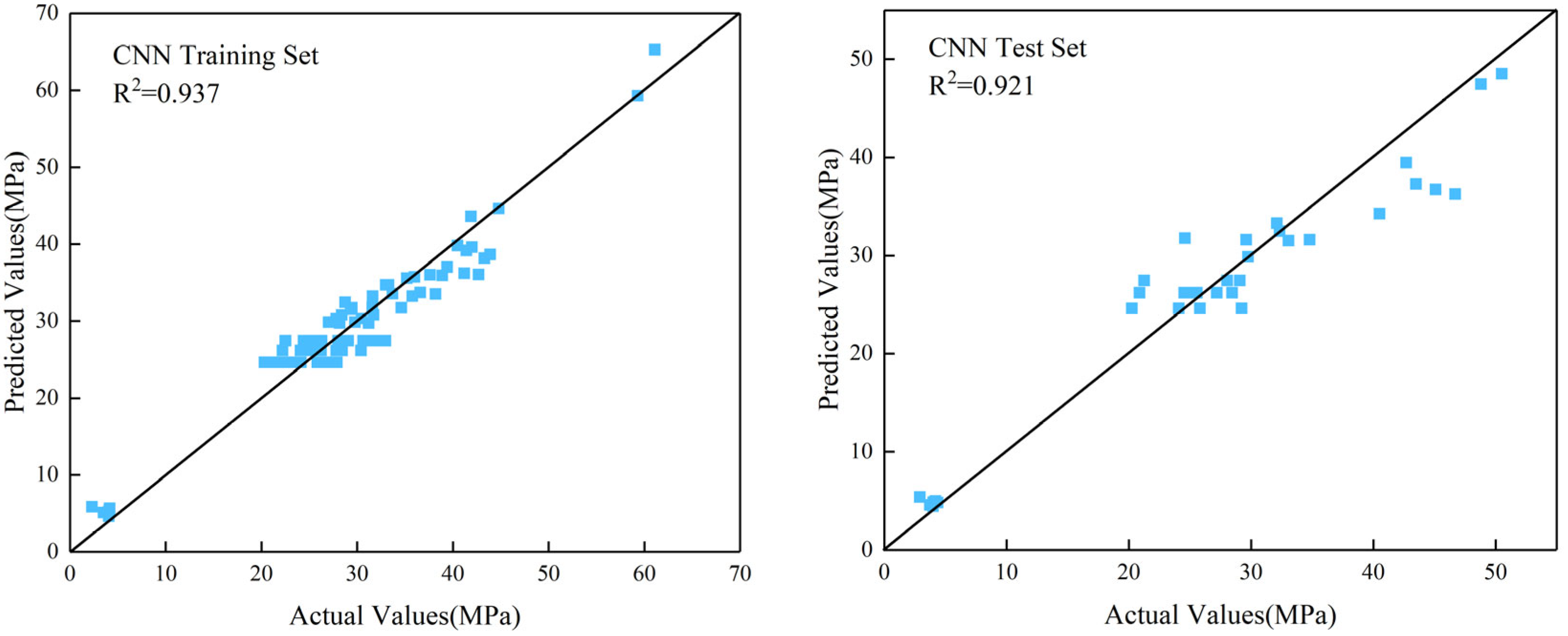
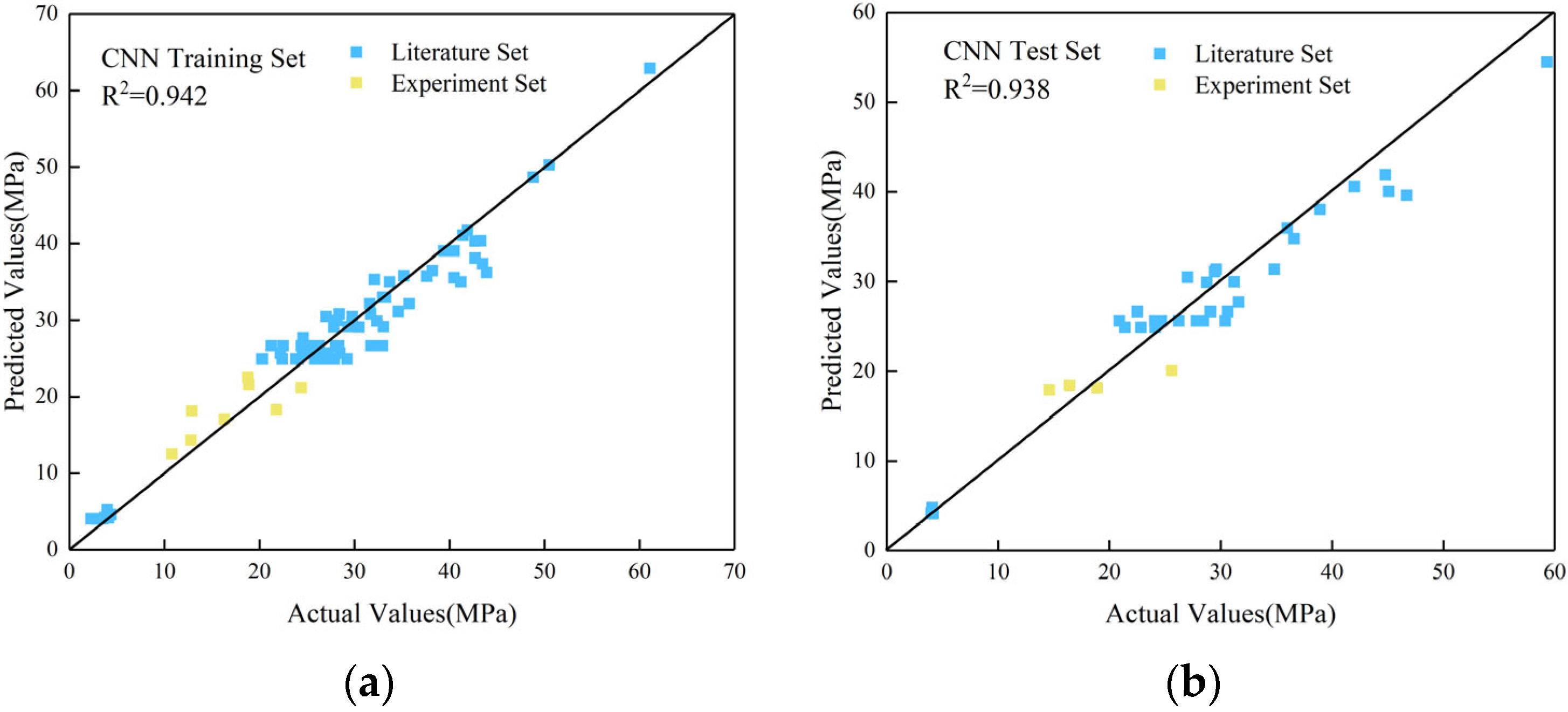
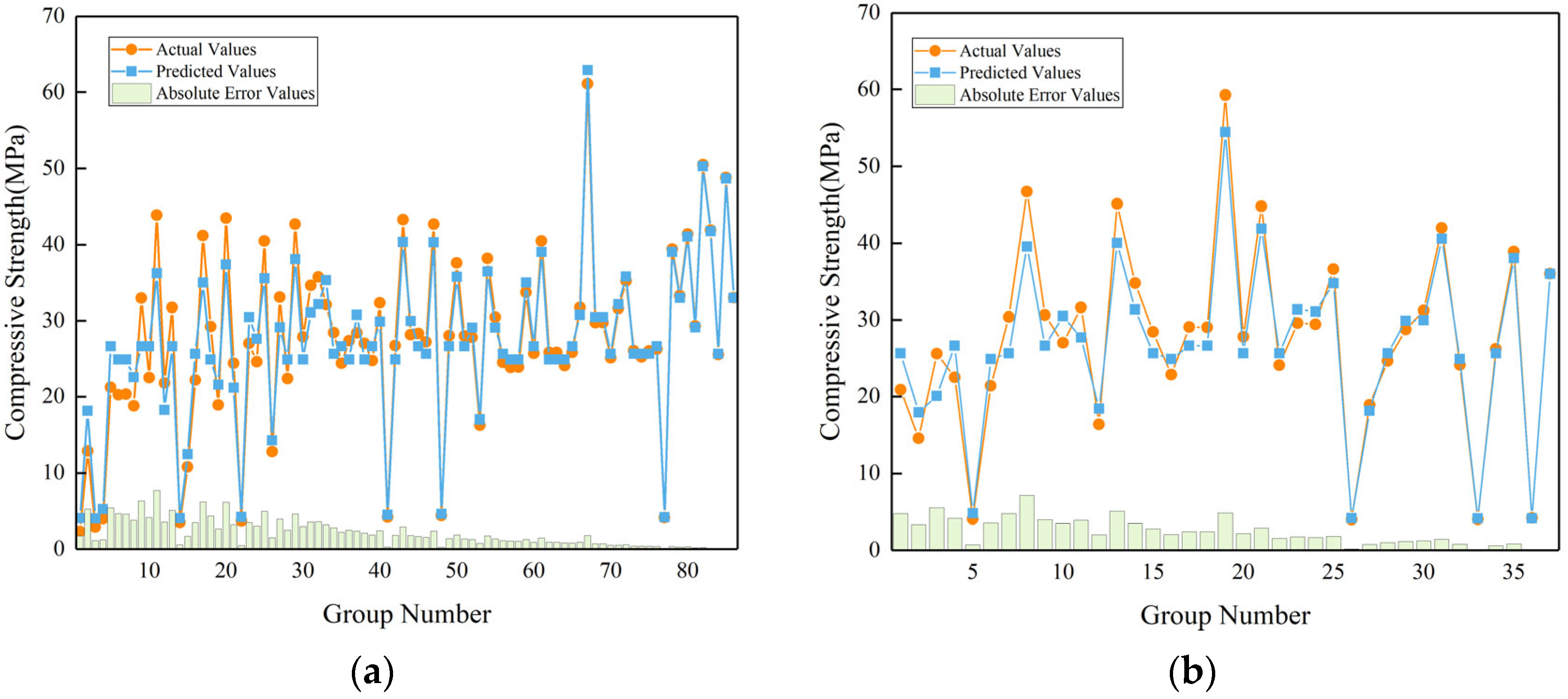
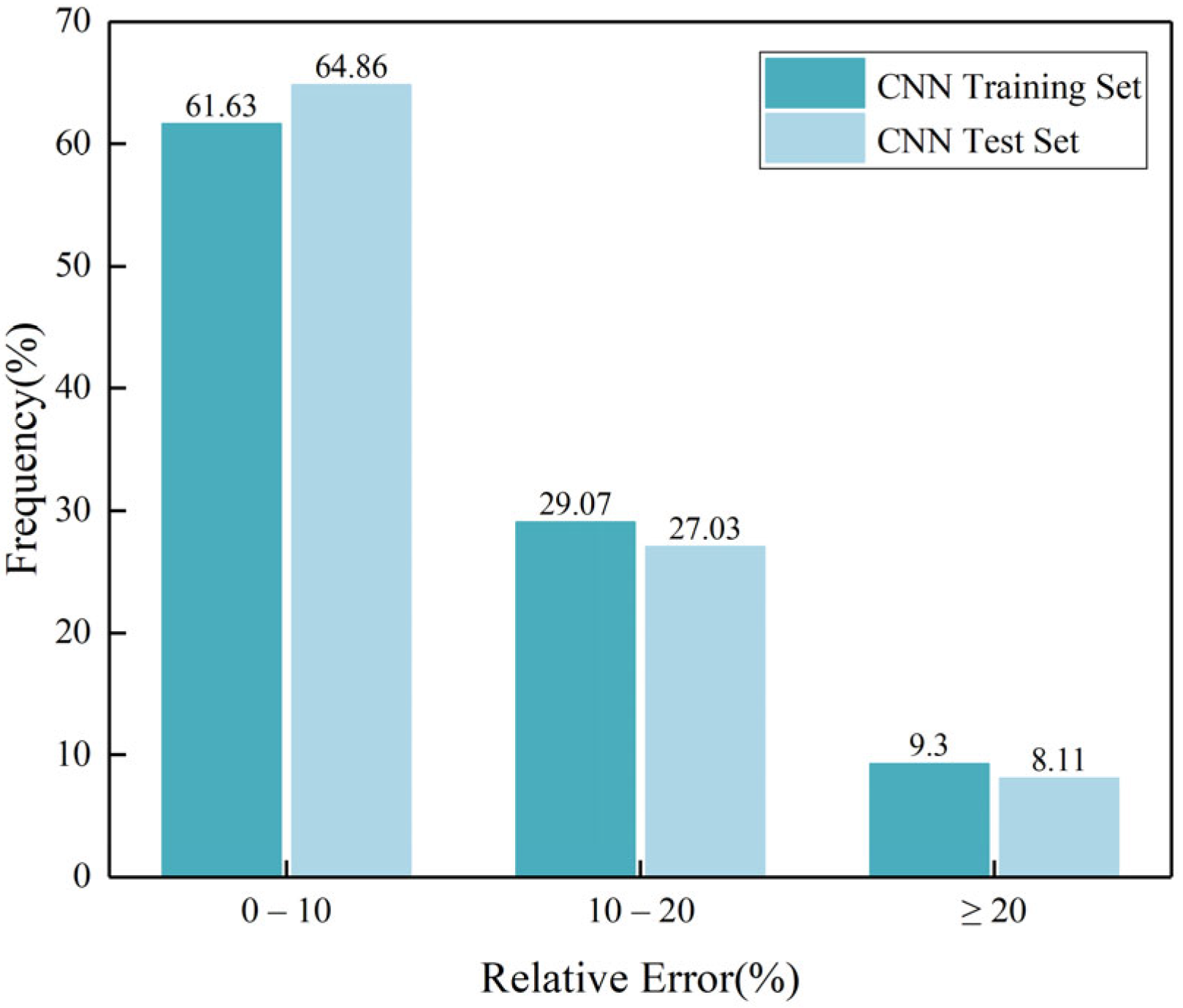
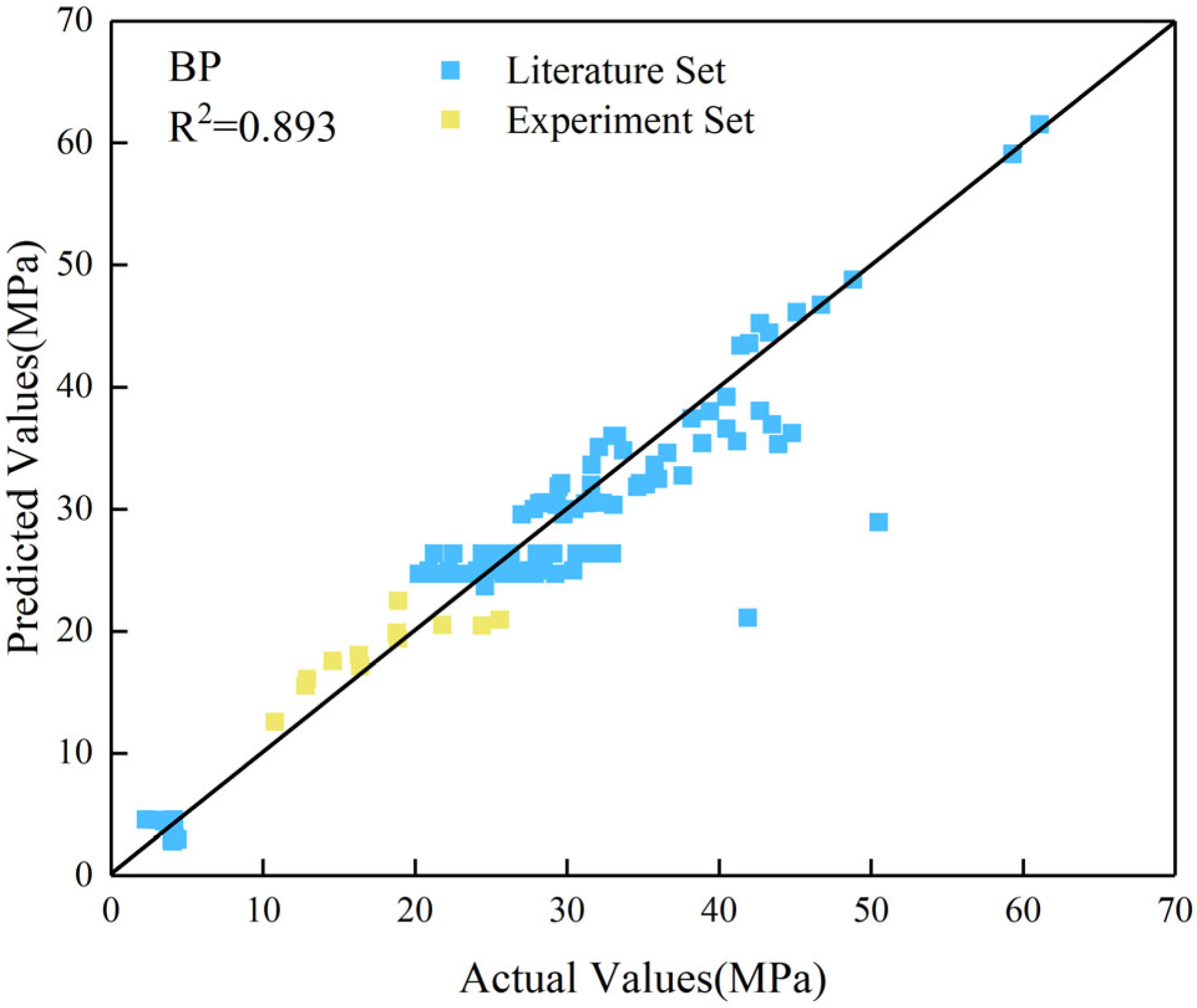
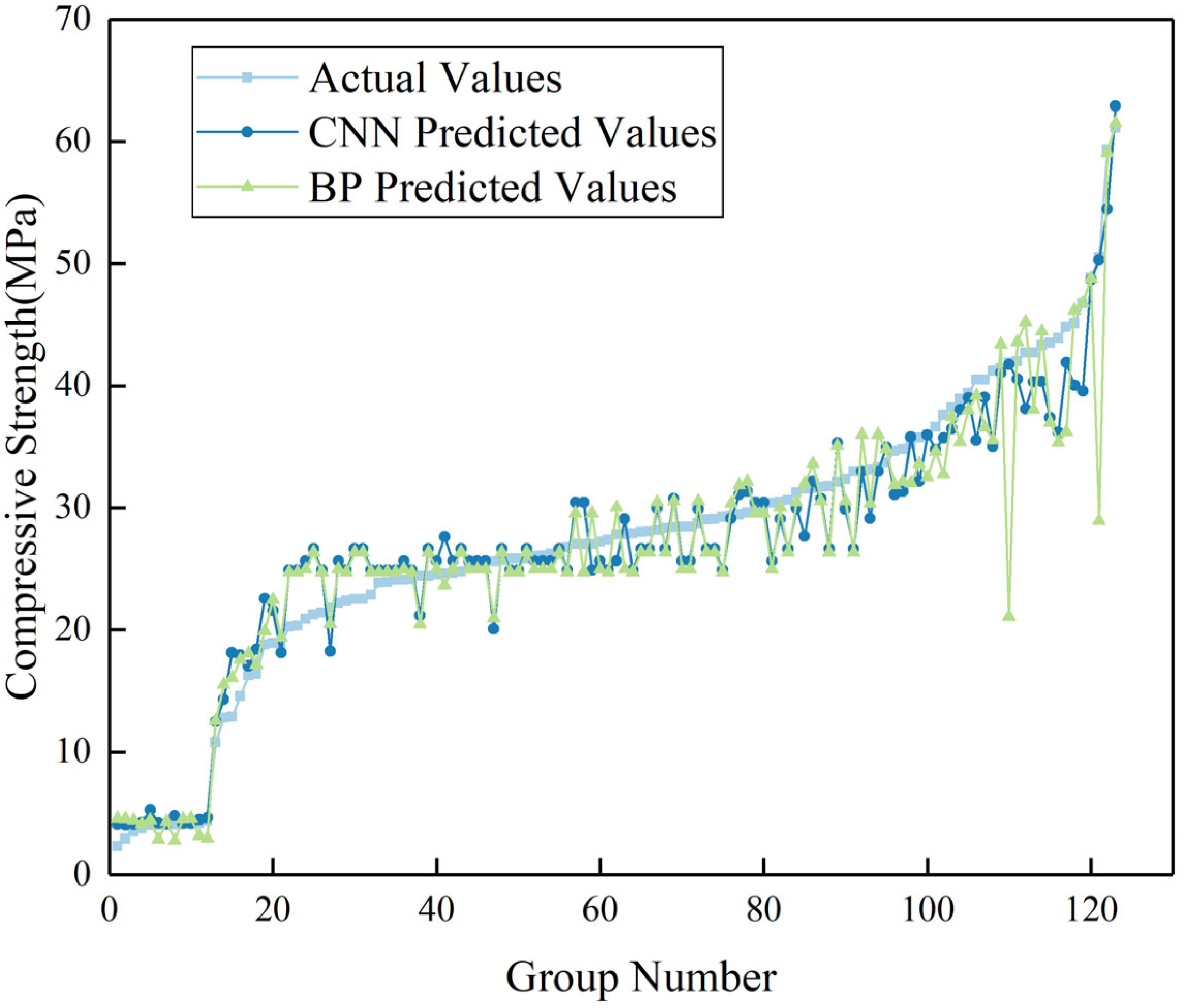
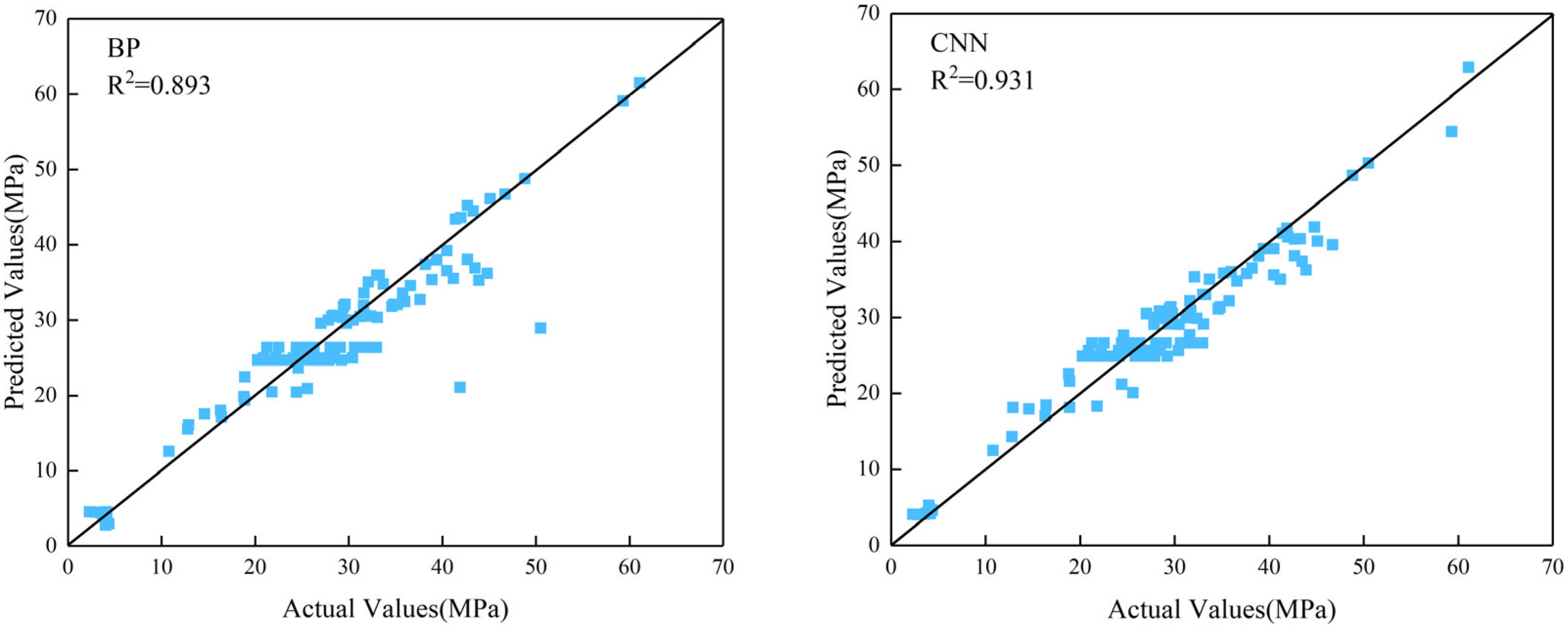
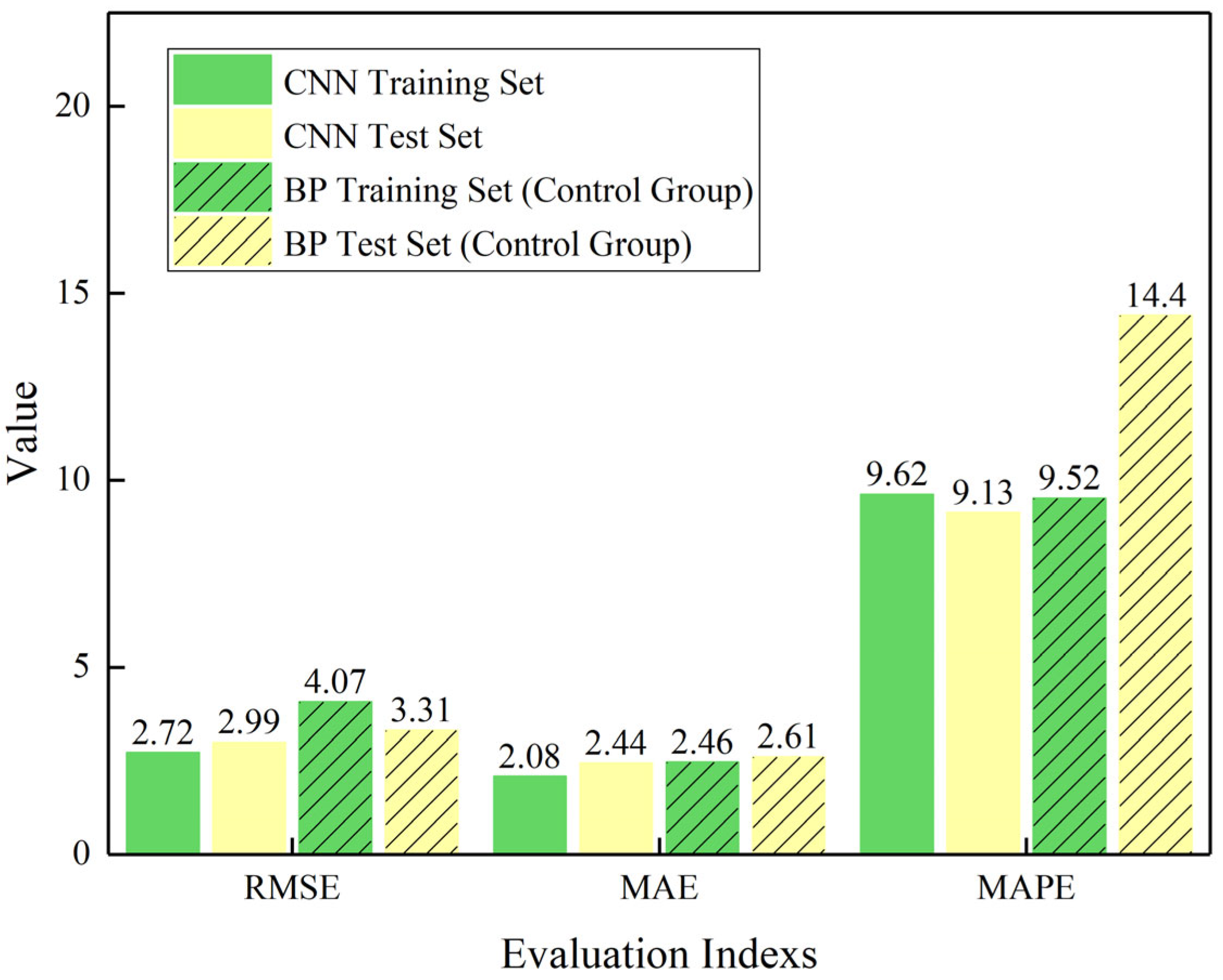
| Nomenclature of the Model | Method Class | Model | R2 |
|---|---|---|---|
| : compressive strength; : total porosity; : mean pore size; : diameter of the aggerate particles. | First-order multivariate function model [23] | 0.99 | |
| : compressive strength; : porosity. | Logarithmic function model [24] | 0.98 | |
| : cube compressive strength; : height of the specimen; : size of aggregate. | Power function [25] | 0.87 | |
| : compressive strength; : replacement rates of ground granulated blast-furnace slag; : replacement rates of recycled concrete aggregates; : replacement rates of recycled fine glass. | First-order multivariate function model [26] | 0.87 | |
| : compressive strength; : ultrasonic pulse velocity. | Power function [27] | 0.80 | |
| : compressive strength; : porosity. | Linear regression model [8] | 0.71 | |
| : compressive strength; : density. | Linear regression model [22] | 0.63 |
| Reference | Curing Age (Days) | Type of Curing | Type of Cement | Type of Filler | Type of Aggregate | ||
|---|---|---|---|---|---|---|---|
| CA | FA | ||||||
| 1 | Seeni Bright Singh et al. [48] | 28 | Moist | Ordinary Portland Cement | Fly Ash | Gravel | |
| 2 | Bright Singh Seeni et al. [49] | 28 | Moist | Ordinary Portland Cement | Silica Fume | Gravel | |
| 3 | Yafei Sun et al. [50] | 28 | Moist | Ordinary Portland Cement | Fly Ash | Natural Gravel | |
| 4 | Ayda S. Agar-Ozbek et al. [51] | 28 | be Wrapped with Aluminum and Plastic Foils (20 °C) | CEM I 52.5 | Microsilica | Crushed Basalt and River Gravel | Crushed Basalt |
| 5 | Yu Chen et al. [52] | 28 | Moist | ASTM Type I | Fly Ash and Silica Fume | Granite | |
| 6 | M. Rezania et al. [53] | 28 | Maintained Into a Pool (23 ± 2 °C) | Ordinary Portland Cement | Lightweight Aggregate | Dry Apparent Specific Weight: 1600 kg/m3 | |
| Mixture | Coarse Aggregates (kg/m3) | Cement (kg/m3) | Fly Ash (kg/m3) | Water (kg/m3) | Fresh Concrete Bulk Density (kg/m3) |
|---|---|---|---|---|---|
| Mix 1 | 1532 | 300 | 90 | 90 | 1863 |
| Mix 2 | 1532 | 300 | 178 | 110 | 1945 |
| Mix 3 | 1532 | 300 | 279 | 111 | 2065 |
| Mix 4 | 1532 | 350 | 74 | 94 | 1884 |
| Mix 5 | 1532 | 350 | 144 | 109 | 1967 |
| Mix 6 | 1532 | 350 | 237 | 123 | 2039 |
| Mix 7 | 1532 | 400 | 40 | 94 | 1876 |
| Mix 8 | 1532 | 400 | 115 | 109 | 1958 |
| Mix 9 | 1532 | 400 | 189 | 120 | 2098 |
| Mix 10 | 1532 | 450 | 10 | 98 | 1855 |
| Mix 11 | 1532 | 450 | 69 | 104 | 1965 |
| Mix 12 | 1532 | 450 | 159 | 117 | 2075 |
| Mixture | Measured Porosity (%) | 28 d Compressive Strength (MPa) |
|---|---|---|
| Mix 1 | 24.9 | 10.8 |
| Mix 2 | 20.4 | 12.9 |
| Mix 3 | 15.9 | 16.4 |
| Mix 4 | 24.3 | 12.8 |
| Mix 5 | 19.2 | 14.6 |
| Mix 6 | 16.5 | 18.8 |
| Mix 7 | 23.2 | 16.3 |
| Mix 8 | 21.1 | 18.9 |
| Mix 9 | 14.3 | 24.4 |
| Mix 10 | 24.5 | 18.9 |
| Mix 11 | 21.1 | 21.8 |
| Mix 12 | 15.3 | 25.6 |
| Data Set | Performance Measures | |||
|---|---|---|---|---|
| R2 | RMSE (MPa) | MAPE (%) | MAE (MPa) | |
| Training set | 0.942 | 2.716 | 9.621 | 2.080 |
| Test set | 0.938 | 2.997 | 9.134 | 2.440 |
Disclaimer/Publisher’s Note: The statements, opinions and data contained in all publications are solely those of the individual author(s) and contributor(s) and not of MDPI and/or the editor(s). MDPI and/or the editor(s) disclaim responsibility for any injury to people or property resulting from any ideas, methods, instructions or products referred to in the content. |
© 2024 by the authors. Licensee MDPI, Basel, Switzerland. This article is an open access article distributed under the terms and conditions of the Creative Commons Attribution (CC BY) license (https://creativecommons.org/licenses/by/4.0/).
Share and Cite
Yu, G.; Zhu, S.; Xiang, Z. The Prediction of Pervious Concrete Compressive Strength Based on a Convolutional Neural Network. Buildings 2024, 14, 907. https://doi.org/10.3390/buildings14040907
Yu G, Zhu S, Xiang Z. The Prediction of Pervious Concrete Compressive Strength Based on a Convolutional Neural Network. Buildings. 2024; 14(4):907. https://doi.org/10.3390/buildings14040907
Chicago/Turabian StyleYu, Gaoming, Senlai Zhu, and Ziru Xiang. 2024. "The Prediction of Pervious Concrete Compressive Strength Based on a Convolutional Neural Network" Buildings 14, no. 4: 907. https://doi.org/10.3390/buildings14040907
APA StyleYu, G., Zhu, S., & Xiang, Z. (2024). The Prediction of Pervious Concrete Compressive Strength Based on a Convolutional Neural Network. Buildings, 14(4), 907. https://doi.org/10.3390/buildings14040907






